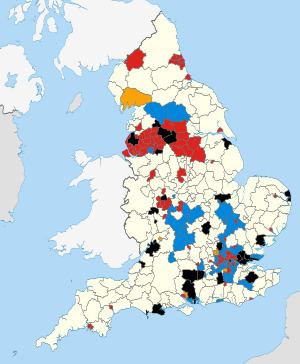22 May 2014 2015 → 31% 29% 6 11 Start date May 22, 2014 | 25 September 2010 6 December 2005 82 41 2,121 1,364 | |
 | ||
The 2014 United Kingdom local elections were held on 22 May 2014. Usually these elections are held on the first Thursday in May but were postponed to coincide with the 2014 European Parliament Elections. Direct elections were held for all 32 London boroughs, all 36 metropolitan boroughs, 74 district/borough councils, 20 unitary authorities and various mayoral posts in England and elections to the new councils in Northern Ireland.
Contents
- England
- Shift of control
- London boroughs
- Metropolitan boroughs
- Unitary authorities
- Whole council
- Half of council
- Third of council
- Mayoral elections
- Northern Ireland
- Party composition of new councils
- Votes cast
- Eligibility to vote
- Enacting legislation
- References
All registered electors (British, Irish, Commonwealth and European Union citizens) who were aged 18 or over on the day of the election were entitled to vote in the local elections.
For the fourth year running, the Labour Party enjoyed the largest share of the vote in local elections, but its share of the vote was its smallest since 2010. The UK Independence Party, which topped the same day's European elections, finished third with 17% of the votes, claiming council seats from Labour, the Conservatives and Liberal Democrats.
England
Overall in England:
The Respect Party lost both their remaining councillors.
Shift of control
This table depicts how the control of local councils shifted in this election.
The data along the diagonal represents no shift in control in that number of councils: for example, Chorley was among the solid colour no change 73 Labour controlled councils. The other cells represent the shifts of control: for example, Harrow was one of five councils of which Labour gained control from No Overall Control. The intensity of the colour in a table cell other than the diagonal reflects the relative number of losses in council control suffered by each party.
Last updated at 11:30:10 on 27 May 2014
London boroughs
All seats in the 32 London Borough Councils were up for election.
Harrow's Council was elected in 2010 with a Labour majority but divisions within this majority in 2013 led to a coalition struck between the Conservatives and the Independent Labour Group (formed of eight ex-Labour councillors). Conservatives withdrew their support for Independent Labour on 16 September 2013 leading to a brief Conservative minority administration.
Metropolitan boroughs
One third of the seats in all 36 Metropolitan Boroughs were up for election (showing those elected and each party's total in the new council).
Unitary authorities
Two unitary authorities had all of their seats up for election following boundary changes.
One third of the council seats were up for election in 17 unitary authorities (elected and totals shown).
Whole council
Two district councils had all of their seats up for election following boundary changes.
Half of council
Seven district councils had half of their seats up for election (showing those elected and the new council).
Third of council
65 district councils had one third of their seats up for election.
† Elected councillors will hold office for one year only as Purbeck District will adopt whole council elections from 2015.
Mayoral elections
There were five mayoral elections.
Northern Ireland
These were the first elections to the 11 new 'super-councils' in Northern Ireland, following a reorganisation. These will operate in shadow form for one year, with the current 26 councils existing in parallel.
Party composition of new councils
The party abbreviations in this table are explained in the total-vote table that follows it.
Votes cast
These elections used the Single Transferable Vote method of proportional representation. Votes and percentages for each party reflect the first preference on each ballot.
Eligibility to vote
All registered electors (British, Irish, Commonwealth and European Union citizens) who were aged 18 or over on the day of the election were entitled to vote in the local elections. Those who were temporarily away from their ordinary address (for example, away working, on holiday, in student accommodation or in hospital) were also entitled to vote in the local elections, although those who have moved abroad and registered as overseas electors cannot vote in the local elections. Those who were registered to vote at more than one address (such as a university student who has a term-time address and lives at home during holidays) were entitled to vote in the local elections at each address, as long as they were not in the same local government area.
Enacting legislation
These elections were held on 22 May 2014 as provided by 'The Local Elections (Ordinary Day of Elections in 2014) Order 2013' (S.I. 2013/2277).
